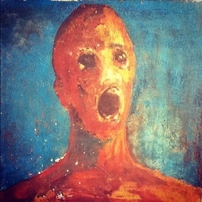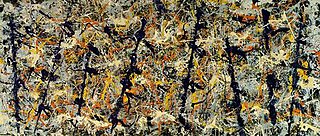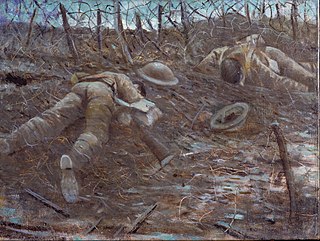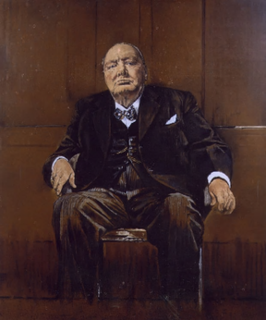 W
WThe Anguished Man is a painting created by an unknown artist and owned by Sean Robinson. According to Robinson, who claims to have inherited the painting from his grandmother, the artist who created the painting allegedly mixed his own blood into the paint and died by suicide soon after finishing the work. The painting has been characterized as being supposedly haunted. Robinson has uploaded video recordings of the painting to his YouTube channel.
 W
WBlue Poles, also known as Number 11, 1952 is an abstract expressionist painting by American artist Jackson Pollock. It was purchased amid controversy by the National Gallery of Australia in 1973 and today remains one of the gallery's major paintings.
 W
WA Burial At Ornans is a painting of 1849–50 by Gustave Courbet, and one of the major turning points of 19th-century French art. The painting records the funeral in September 1848 of his great-uncle in the painter's birthplace, the small town of Ornans. It treats an ordinary provincial funeral with unflattering realism, and on the giant scale traditionally reserved for the heroic or religious scenes of history painting. Its exhibition at the 1850–51 Paris Salon created an "explosive reaction" and brought Courbet instant fame. It is currently displayed at the Musée d'Orsay in Paris, France.
 W
WLe Chemin, Paysage à Meudon also known as Paysage avec personage, is an oil on canvas painted in 1911 by the artist, theorist and writer Albert Gleizes. The work was exhibited at the Salon des Indépendants during the spring of 1911, Paris; Les Indépendants, Musée moderne de Bruxelles, 1911; Galeries Dalmau, Exposicio d'art cubista, Barcelona, 1912; Galerie La Boétie, Salon de La Section d'Or, 1912. The painting was reproduced in the journal Le Siècle (1912) in an article titled Enquête sur le Cubisme, by Olivier Hourcade.
 W
WThe Crying Boy is a mass-produced print of a painting by Italian painter Giovanni Bragolin. This was the pen-name of the painter Bruno Amarillo. It was widely distributed from the 1950s onwards.
 W
WDanseuse au café is a large oil painting created in 1912 by the French artist and theorist Jean Metzinger (1883–1956). The work was exhibited in Paris at the Salon d'Automne of 1912, entitled Danseuse. The Cubist contribution to the 1912 Salon d'Automne created a controversy in the Municipal Council of Paris, leading to a debate in the Chambre des Députés about the use of public funds to provide the venue for such 'barbaric' art. The Cubists were defended by the Socialist deputy, Marcel Sembat. This painting was realized as Albert Gleizes and Jean Metzinger, in preparation for the Salon de la Section d'Or, published a major defence of Cubism, resulting in the first theoretical essay on the new movement, Du "Cubisme". Danseuse au café was first reproduced in a photograph published in an article entitled Au Salon d'Automne "Les Indépendants" in the French newspaper Excelsior, 2 Octobre 1912. The painting is now located at the Albright-Knox Art Gallery, Buffalo New York.
 W
WPortrait of Daniel-Henry Kahnweiler is an oil on canvas painting by Pablo Picasso in the Analytical Cubism style. It was completed in the autumn of 1910 and depicts the prominent art dealer Daniel-Henry Kahnweiler, who played an important role in supporting Cubism. The painting is housed in the collection of the Art Institute of Chicago.
 W
WDegenerate art was a term adopted in the 1920s by the Nazi Party in Germany to describe modern art. During the dictatorship of Adolf Hitler, German modernist art, including many works of internationally renowned artists, was removed from state-owned museums and banned in Nazi Germany on the grounds that such art was an "insult to German feeling", un-German, Jewish, or Communist in nature. Those identified as degenerate artists were subjected to sanctions that included being dismissed from teaching positions, being forbidden to exhibit or to sell their art, and in some cases being forbidden to produce art.
 W
WLes Demoiselles d'Avignon is a large oil painting created in 1907 by the Spanish artist Pablo Picasso. The work, part of the permanent collection of the Museum of Modern Art, portrays five nude female prostitutes in a brothel on Carrer d'Avinyó, a street in Barcelona. Each figure is depicted in a disconcerting confrontational manner and none is conventionally feminine. The women appear slightly menacing and are rendered with angular and disjointed body shapes. The figure on the left exhibits facial features and dress of Egyptian or southern Asian style. The two adjacent figures are shown in the Iberian style of Picasso's native Spain, while the two on the right are shown with African mask-like features. The ethnic primitivism evoked in these masks, according to Picasso, moved him to "liberate an utterly original artistic style of compelling, even savage force."
 W
WDeux Nus is an early Cubist painting by the French artist and theorist Jean Metzinger. The work was exhibited at the first Cubist manifestation, in Room 41 of the 1911 Salon des Indépendants, Paris. At this exhibition the Cubist movement was effectively launched before the general public by five artists: Metzinger, Gleizes, Le Fauconnier, Delaunay and Léger. This was the first exhibition during which artists, writers, critics and the public at large encountered and spoke about Cubism. The result of the group show is a succès de scandale.
 W
WEn Canot is a Cubist oil painting created by Jean Metzinger in 1913. The work is referred to in various publications as Femme à l'ombrelle, Im Boot, Le Canot, En Bâteau, In the Canoe, The Boat, On the Beach, Am Strand, Im Schiff, V Člunu and Im Kanu. The painting was exhibited in Paris at the 1913 Salon d'Automne. The following year it was shown at Moderní umění, 45th Exhibition of SVU Mánes in Prague, February–March 1914. This "Survey of Modern Art" was one of the last prewar exhibitions in Prague. En Canot was exhibited again, in July of the same year, at the Galerie Der Sturm, Berlin. The painting was acquired from Herwarth Walden in 1916 by Georg Muche at Galerie Der Sturm.
 W
WSanford Robinson Gifford was an American landscape painter and one of the leading members of the Hudson River School. Gifford's landscapes are known for their emphasis on light and soft atmospheric effects, and he is regarded as a practitioner of Luminism, an offshoot style of the Hudson River School.
 W
WLe Goûter, also known as Tea Time (Tea-Time), and Femme à la Cuillère is an oil painting created in 1911 by the French artist and theorist Jean Metzinger (1883–1956). It was exhibited in Paris at the Salon d'Automne of 1911, and the Salon de la Section d'Or, 1912.
 W
WThe Hands Resist Him is a painting created by artist Bill Stoneham in 1972. It depicts a young boy and a female doll standing in front of a glass paneled door, against which many hands are pressed. According to Stoneham, the boy is based on a photograph of himself at age five. The doorway is a representation of the dividing line between the waking world and the world of fantasy and impossibilities, while the doll is a guide that will escort the boy through it. The titular hands represent alternate lives or possibilities. The painting became the subject of an urban legend and a viral internet meme in February 2000 when it was posted for sale on eBay along with a description implying that it was haunted.
 W
WHylas and the Nymphs is an 1896 oil painting by John William Waterhouse. The painting depicts a moment from the Greek and Roman legend of the tragic youth Hylas, based on accounts by Ovid and other ancient writers, in which the enraptured Hylas is abducted by Naiads while seeking drinking water.
 W
WNabil Kanso is an American painter. Kanso began his career in New York. His works deal with contemporary, historical and literary themes, and are marked by figurative imagery executed with spontaneous and vigorous handling of the paint and often done on large-scale formats. They reflect movement and tension embodying intense colors and symbolic forms addressing social, political, and war issues. The Vietnam War and the Lebanese Civil War have profoundly affected the development and scope of his themes dealing with violence and war. His long-running Split of Life series encompasses an extensive range of enormous paintings depicting scenes of human brutality and suffering.
 W
WMan at the Crossroads (1934) was a fresco by Diego Rivera in New York City's Rockefeller Center. It was originally slated to be installed in the lobby of 30 Rockefeller Plaza, the main building of the center. Man at the Crossroads showed the aspects of contemporary social and scientific culture. As originally installed, it was a three-paneled artwork. A central panel depicted a worker controlling machinery. The central panel was flanked by two other panels, The Frontier of Ethical Evolution and The Frontier of Material Development, which respectively represented socialism and capitalism.
 W
WMan on a Balcony, is a large oil painting created in 1912 by the French artist, theorist and writer Albert Gleizes (1881–1953). The painting was exhibited in Paris at the Salon d'Automne of 1912. The Cubist contribution to the salon created a controversy in the French Parliament about the use of public funds to provide the venue for such 'barbaric art'. Gleizes was a founder of Cubism, and demonstrates the principles of the movement in this monumental painting with its projecting planes and fragmented lines. The large size of the painting reflects Gleizes's ambition to show it in the large annual salon exhibitions in Paris, where he was able with others of his entourage to bring Cubism to wider audiences.
 W
WMan Proposes, God Disposes is an 1864 oil-on-canvas painting by Edwin Landseer. The work was inspired by the search for Franklin's lost expedition which disappeared in the Arctic after 1845. The painting is in the collection of Royal Holloway, University of London, and is the subject of superstitious urban myth that the painting is haunted.
 W
WOpen Casket is a 2016 painting by Dana Schutz. The subject is Emmett Till, a black 14-year-old boy who was lynched by two white men in Mississippi in 1955. It was one of the works included at the 2017 Whitney Biennial exhibition in New York curated by Christopher Y. Lew and Mia Locks. The painting caused controversy, with protests and calls for the painting's destruction. These may have been merely rhetorical. Protests inside the museum petered out in a day or two.
 W
WAdolf Hitler, leader of the Nazi Party in Germany in the years leading up to and during World War II, was also a painter. He produced hundreds of works and sold his paintings and postcards to try to earn a living during his Vienna years (1908–1913). Despite little success professionally, he continued to paint throughout his life.
 W
WPaths of Glory is a 1917 painting by British artist Christopher Nevinson. The title quotes from a line from Thomas Gray's 1750 poem Elegy Written in a Country Churchyard: "The paths of glory lead but to the grave". It is held by the Imperial War Museum in London, which describes it as "one of Nevinson's most famous paintings".
 W
WIn 1671 an argument broke out in the French Royal Academy of Painting and Sculpture in Paris about whether drawing or color was more important in painting. On one side stood the Poussinists who were a group of French artists, named after the painter Nicolas Poussin, who believed that drawing was the most important thing. On the other side were the Rubenists, named after Peter Paul Rubens, who prioritized color. There was a strong nationalistic flavour to the debate as Poussin was French but Rubens was Flemish, though neither was alive at the time. After over forty years the final resolution of the matter in favor of the Rubenists was signalled when Antoine Watteau's The Embarkation for Cythera was accepted as his reception piece by the French Academy in 1717. By that time the French Rococo was in full swing.
 W
WThe Sick Child is the title given to a group of six paintings and a number of lithographs, drypoints and etchings completed by the Norwegian artist Edvard Munch between 1885 and 1926. All record a moment before the death of his older sister Johanne Sophie (1862–1877) from tuberculosis at 15. Munch returned to this deeply traumatic event repeatedly in his art, over six completed oil paintings and many studies in various media, over a period of more than 40 years. In the works, Sophie is typically shown on her deathbed accompanied by a dark-haired, grieving woman assumed to be her aunt Karen; the studies often show her in a cropped head shot. In all the painted versions Sophie is sitting in a chair, obviously suffering from pain, propped by a large white pillow, looking towards an ominous curtain likely intended as a symbol of death. She is shown with a haunted expression, clutching hands with a grief-stricken older woman who seems to want to comfort her but whose head is bowed as if she cannot bear to look the younger girl in the eye.
 W
WIn 1954, the English artist Graham Sutherland was commissioned to paint a full-length portrait of Prime Minister Sir Winston Churchill of the United Kingdom. Sutherland received 1,000 guineas in compensation for the painting, a sum funded by donations from members of the House of Commons and House of Lords. The painting was presented to Churchill by both Houses of Parliament at a public ceremony in Westminster Hall on his 80th birthday on 30 November 1954.
 W
WAvdey Stepanovich Ter-Oganyan is a Russian painter, one of the prominent representatives of the Moscow actionism.
 W
WThe Spring is a large oil painting created in 1912 by the French artist Francis Picabia. The work, both Cubist and abstract, was exhibited in Paris at the Salon d'Automne of 1912. The Cubist contribution to the 1912 Salon d'Automne created a controversy in the Municipal Council of Paris, leading to a debate in the Chambre des Députés about the use of public funds to provide the venue for such 'barbaric' art. The Cubists were defended by the Socialist deputy, Marcel Sembat. This painting was realized as Albert Gleizes and Jean Metzinger, in preparation for the Salon de la Section d'Or, published a major defence of Cubism, resulting in the first theoretical essay on the new movement, Du «Cubisme». The painting forms part of the permanent collection of the Museum of Modern Art, New York City.
 W
WVoice of Fire is an acrylic on canvas abstract painting made by American painter Barnett Newman in 1967. It consists of three equally sized vertical stripes, with the outer two painted blue and the centre painted red. The work was created as a special commission for Expo 67. In 1987 it was loaned to the National Gallery of Canada in Ottawa, Ontario, Canada.
 W
WWater Serpents II, also referred to as Wasserschlangen II, is an oil painting made by Gustav Klimt in 1907. It is the follow-up painting to the earlier painting Water Serpents I. Like the first painting, Water Serpents II deals with the sensuality of women's bodies and same-sex relationships. The painting has a rich history. During World War II, it was stolen by the Nazis, and more recently, it has been the center of a controversy surrounding its record 2013 sale. As of December 2019, it is the 6th most expensive painting in the world and the most expensive work by Klimt to sell.
 W
WWoman with a Hat is a painting by Henri Matisse. An oil on canvas, it depicts Matisse's wife, Amelie. It was painted in 1905 and exhibited at the Salon d'Automne during the fall of the same year, along with works by André Derain, Maurice de Vlaminck and several other artists known as "Fauves".